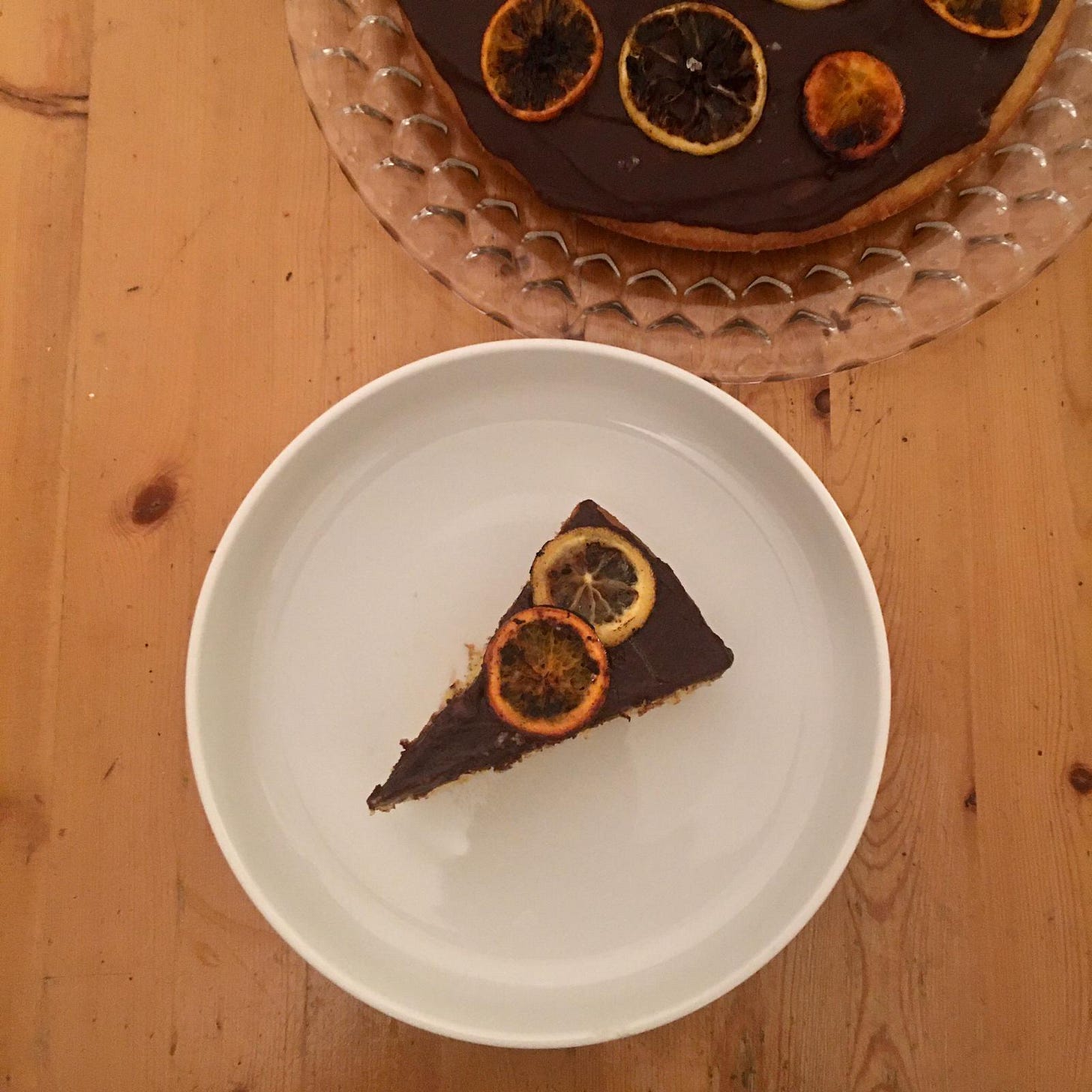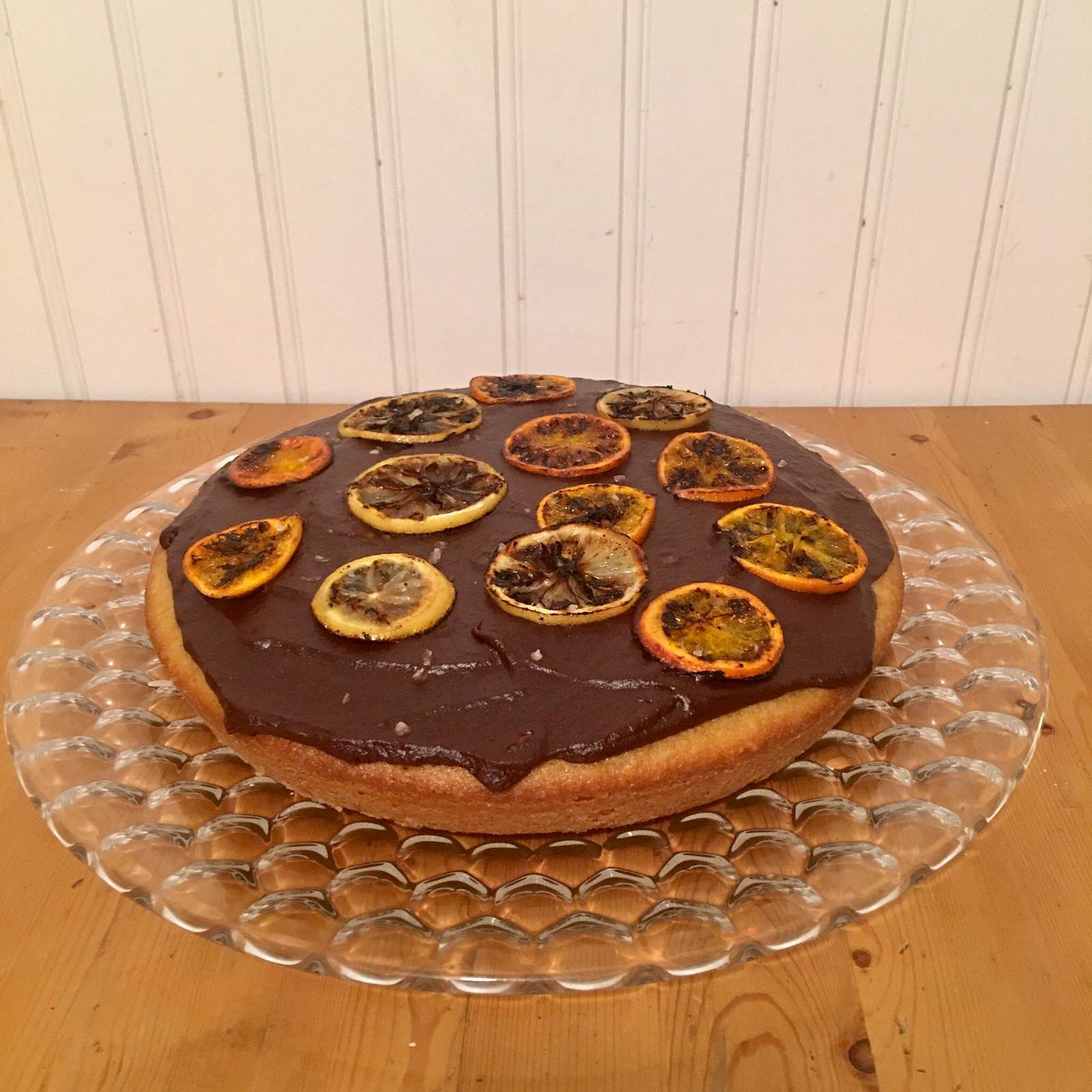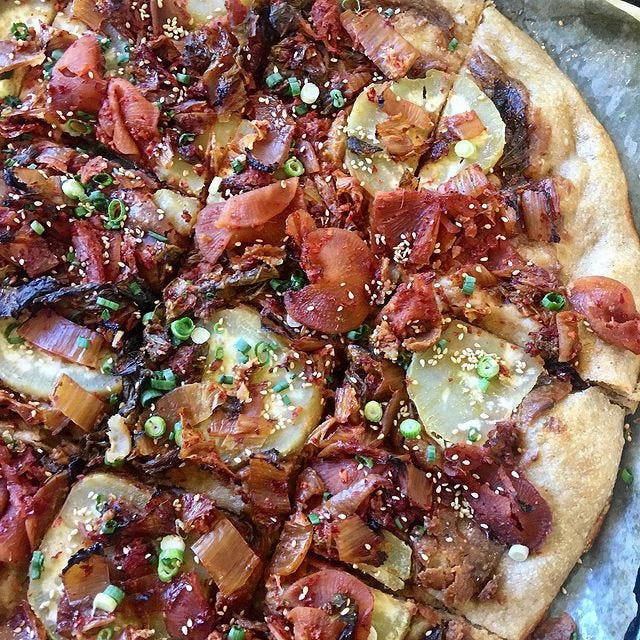Kitchen Urban Legends 👻 | The Best Food Scenes in Horror Movies | Recipe: Orange and Chocolate Cake
Issue No. 17
In this week’s Sunshine + Microbes, Jackie dispels classic cooking myths. Plus, another fermentation pro shares her sweet origin story and we discuss the freaky food moments in cinema. Oh and there’s some scrumptious cake to die for…. Happy Halloween! 🦇
If you enjoyed this newsletter, please forward it to friends (and give our Facebook and Instagram pages a follow). And if someone shared this newsletter with you, subscribe below.

Let’s tackle a few spoooooky food urban legends. The stuff we’ve been scared into doing in the kitchen (or not doing, or not eating) for no good reason. So let’s put some of these ghosts to bed, to save time and energy for what really matters: Eating sour patch kids and watching Hocus Pocus.
Myth 1: You should peel root vegetables. No, stop it. The veggie’s peels contain a significant proportion of the fiber and nutrition. Don’t remove that good stuff. The peels are neither contaminated with dirt nor evil spirits. This is what a carrot looks like when it comes out of the ground:
If the carrot doesn’t look like that, then it has been thoroughly cleaned. Unsure? Go ahead and clean it again with water. Wash, don’t peel. Some veggie peels, such as gourds like squash, are too tough to eat enjoyably. Peel them. Leave the other guys in tact.
Myth 2: You should add oil to pasta water. It doesn’t do anything. It doesn’t keep pasta from sticking together once it’s cooked. It doesn’t keep the water from boiling over.
Myth 2a: Here’s a couple other things you shouldn’t do when boiling pasta. No need to cook pasta in two times the amount of water. It will cook just fine in a “crowded pot”, as long as there is enough water to cover the pasta as it expands. Don’t rinse the pasta with cold water after you drain it. That removes the starch that helps the sauce cling to it. But for goddess’ sake, salt that water (so it tastes like the ocean!) before you cook the pasta.
Myth 3: Cooking vegetables destroys their nutrients. Raw food enthusiasts avow that heat destroys the nutrients that make food healthy. While there seems to be a handful of compounds in particular vegetables that are rendered useless in the cooking process, that doesn’t mean food shouldn’t be cooked. In fact, many studies have found that cooking veggies can actually help the body absorb certain nutrients by making them more digestible. Like with most things, balance is key. Eat a variety of vegetables, prepared in a variety of ways.
Myth 4: MSG is bad for you. This is one of the most notorious cooking urban legends. It’s part fear-mongering, part prank-gone-wrong, part xenophobia. There is a really great This American Life episode that explores the fascinating saga of how white America became fearful of MSG (monosodium glutamate). But the long and short is, nobody should be. MSG is a salt that produces umami flavor, which makes food delicious. There is absolutely no science to support the idea that it causes headaches or that it is unhealthy in any way.
Got any food urban legends you’d like us to investigate? Ask away at sunshineandmicrobes@gmail.com. Happy Halloween!

love,
Jackie

Pop Culinary Culture
Hey, here’s a new section where we breakdown iconic uses and images of food and drink in TV, film, literature and anywhere else in the pop culture.
Food splatters, it crunches, it drips, it rots, so no wonder things we eat can be a scene stealer during the visceral experience of watching a horror movies. Think of the squirming roasted chicken on the dinner plate in “Eraserhead” or the creepy-crawly infested steak in “Poltergeist.” Yum. For Halloween, Sunshine + Microbes and our ghoulish friends remember scandalous food scenes from spooky classics:
Gremlins: Don’t Feed Them After Midnight
We all know you should never feed a Gremlin after midnight. Although we also all know … it’s always technically “after midnight.”
But thanks to this gap in logic, the zany plot of “Gremlins” unfolds into the critter classic we know and love. The plot especially picks up during a late-night feeding frenzy, after the main human character — whose name is irrelevant — is pestered into feeding some evil baby Gremlins, who are wobbling around like hopped-up loofahs. He doesn’t realize his clock is unplugged and it’s actually after midnight (you had one job, bro). He brings them a plate of chicken drumsticks — that are par baked at best — and the monsters tear into them with repulsive glee.
Albeit brief, the gratuitous closeups that follow are rather upsetting. Feverish chomping and smacking, poultry grease everywhere. Their eyes glazed over like fresh marinade.
Maybe it’s too realistic. They are us, and we are them. Visit a Midwestern barbecue joint during the lunch rush, and you’ll see. Food is love. But watching others eat is horror.
-Andrew Zangre is a writer who drives around a lot. He posts pictures sometimes on Instagram.
The Silence of the Lambs: Cannibalism with fine wine
One of the most quoted lines in horror movie history happens to be about a food and wine pairing. A good one at that. When the serial killer Hannibal Lecter brags to FBI detective Clarice Staring about the time he ate a census taker’s liver with fava beans and a “nice Chianti.”
It’s gross but Hannibal seems to have some wine chops, as a sanguine note in a rustic Tuscan Sangiovese Chianti likely would pair well with human liver and fava beans. His pronunciation of “Chianti,” however, is questionable. The Thomas Harris novel that’s the basis for the film names Amarone della Valpolicella as his wine of choice. Some people might prefer that, although I would say that only works with with an exceptionally rich liver. For a disturbing meal, the elegant cannibal at least knows how to find a decent pairing.
-Sally Stewart and Steven Washuta are sommeliers in the New York City area. Do you love wine? Of course you do. Follow Sally on Instagram!
Se7en: Glutton for Punishment
One frigid night in college, my friend Zach invited me over for dinner and a movie. He cooked some pasta and selected the David Fincher thriller “Se7en.”
In the film’s early moments, two detectives come upon the crime scene of a serial killer who slays his victims according to the Seven Deadly Sins. The first poor soul represents gluttony. He was an obese man, forced to eat spaghetti until his stomach ruptured.
Nope. Suddenly, I’m not hungry for pasta anymore.
-Matt Levin
Did we miss your favorite food horror moment? Share your own appetite-killing choice with sunshineandmicrobes@gmail.com.
Fermentation Origin Stories
Learn how some of our favorite Florida fermentos — pssst, get your tickets to Ferment Fest here — got their start. Jennifer of Hani Honey Company fell for fermentation as a culinarily rebellious teen. Share your own fermentation origin story with us sunshineandmicrobes@gmail.com.
I think my first ferments were pureed kraut and kielbasa with a little farmers cheese, or in a nice bowl of the Polish soup żurek. My family came to the U.S. from Poland, so my childhood was full of traditional foods from Eastern Europe. Back then, it just seemed “normal”. In my teenagehood, when all the crazy things happen, I found myself embracing a vegetarian diet. I lived close enough to New York to satiate my meat cravings with yummy cultural substitutions, from falafel to bibimbap. And in every corner of every culture something was fermented.
Recipe books became my best friends. From there my love of fermentation blossomed . I found one I particularly liked, “Japanese Vegetarian Cooking” by Leslie Downer. She travelled throughout Japan, and gleaned the culture through food and interactions with the people she met there. I found myself forming connections to people from small villages across the globe, where traditions are kept and food celebrated. I fell in love with miso, kimchee, vinegar, tempeh, natto, amazake, sake, yuba, you name it, I was digging it all. Not long after, I found Sandor Katz’s book, “Wild Fermentation.” His passion and curiosity sucked me in for the long haul, moved by his writing style and the strong emphasis on the microbes’ role in health. And I’m so glad it did. I brew whenever I find the time, mead mostly, and forage and harvest what is in my area to introduce yeasts, bacteria, and flavors to the ancient brews. It’s a subtle art, but so completely satisfying, which is my favorite sentiment, about fermentation.
Fresh Links
Our favorite food and environment reads from around the internet. Give’em a click👇
🌮An Oral History of Hard-Shell Tacos | Mel Magazine
Taco Bell didn't invent the hard shell taco, "but they sure did exploit the hell out of them." Interviews with a food historian, LA Times reporter Gustavo Arellano and Michael Montaño (the grandson of the woman who inspired Taco Bell’s business in the 1950s) explain how a traditional Mexican food became the centerpiece of Glenn Bell’s fast food giant.
As Arellano, the author of Taco USA: How Mexican Food Conquered America, states there can be no one originator of the crunchy tacos dorados. The fried tortilla vessels came to the U.S. because “that was just the style of eating tacos that people brought up with them from Mexico.” Read this recounting of the hard-shell tacos’ Americanization: From its arrival in the U.S. to the first celebrity chef of Mexican food in 1914 (a Southern housewife named Bertha Haffner-Ginger, of course) to the proliferation of taco shells in a can to, finally, how Glenn Bell spotted the hard-shelled taco produced by Montaño’s grandmother and mass-produced them in Taco Bells all over the country.
🌧️After the Storm | Guernica
Mary Helgar writes about the day that changed everything about New Orleans for her, and how that shaped her commitment to climate justice. She begins by reminding readers what many might have forgotten but what she “can never forget.” Hurricane Katrina hit New Orleans one day past the 50th anniversary of Emmitt Till’s murder.
The anniversary was the biggest news story in Mississippi before the storm. How far had we come? Or had we stood still? What comes next? There, in my three-generational home of black southerners, I couldn’t not think about the anniversary, even then, even with the storm overhead.
And when the storm hit, Helgar — who grew up on the Mississippi River — saw signs that we had not come very far. Native New Orleanians were “referred to as refugees in their own country”. She recalled local NPR news segments covering the aftermath with “such overt racism it was impossible to trust them” and photos of white neighborhoods where vigilantes patrolled “to keep black people out.”
I never thought that I’d see the Mississippi my grandfather had known when he was my age, or even the one my mother saw. The Mississippi that brutally murdered a 14-year old boy for a wolf whistle that we now know never happened. But Katrina revealed things that I could never unsee.
Read her full essay here.
🔮Hello from the Year 2050 | Time
The year is 2050. New York City still exists, but the Florida coast has moved about 5 miles inland. The current global refugee crisis, driven by brutal heat waves and calamitous storms, dwarfs the one we experienced in the 2010s and 2020s. The “Greta Generation” has reshaped politics and economies around the world, and income inequality has leveled out. We’ve made strides to slow climate change, but the effects from decades of inaction are in full swing.
In this peek into a possible future, constructed based on everything we already know about climate change and everything we need to be doing, author and noted environmentalist Bill McKibben paints a picture of what the next 30 years might look like here on Earth.
(Thanks to Jackie’s Uncle Ronnie for bringing this article to our attention! You, sir, are a hero.)

Orange and Olive Oil Cake with Roasted Citrus and Chocolate Ganache

I made this cake at work last week, and one of the resident artists there proclaimed it the best cake-eating experience of her life. But so much more importantly than the fact that it is exquisitely delicious, YOU ONLY NEED ONE BOWL TO MAKE THIS CAKE! Also it’s black and orange, so Happy Halloween 🎃.
Note: This cake is decadent with the ganache and roasted citrus. For a simpler, everyday cake, skip those steps.
Ingredients
For the cake (adapted from this recipe, but with less sugar)
1 1/2 cups flour (I used a mix of pastry and whole wheat flour, but choose your own adventure)
1 cup granulated sugar
1 teaspoon baking powder
1/4 teaspoon baking soda
1/2 teaspoon salt
2 large eggs
2/3 cup orange juice (fresh is best)
2/3 cup olive oil
Parchment paper
2 teaspoons grated orange zest (optional)
For the ganache (from Sally’s Baking Addiction)
4 oz chocolate (I stan dark Castronovo chocolate)
4 oz heavy cream
For the roasted citrus
Assorted citrus (but definitely orange)
Sugar

Step-by-step
To roast citrus
Preheat oven to 425°F.
Slice citrus into thin rounds. Use approximately 15-20 rounds of citrus to cover the top of the cake. Remove seeds.
Line a baking sheet with parchment or silpat. Place the citrus rounds on the sheet and sprinkle with sugar.
Roast in oven for 10-15 minutes, until the citrus begins to caramelize.
To make the ganache
If in bar form, finely chop chocolate (they should look like little shards). Place in a heatproof bowl.
Bring cream to a gentle simmer.
Pour cream over chocolate. Stir until chocolate is melted and it’s all combined.
To make the cake
Preheat oven to 375 °F. Place a piece of parchment in a 9-inch round cake pan (a springform works well) so the bottom and most of the sides are covered. Lightly coat parchment with a splash of olive oil.
In a large bowl, thoroughly mix flour, sugar, baking powder, baking soda, and salt. Crack eggs directly into the flour mixture, breaking the yolks with the spoon. Add orange juice, olive oil, and zest (if using) and mix until there are no more dry bits of flour.
Pour batter into the parchment-lined pan, and bake on the middle rack in the oven for about 40 minutes. Insert a toothpick to be sure the cake is cooked all the way through. There should be no wet batter sticking to the toothpick. Let the cake cool in the pan for 5 minutes. Carefully remove cake from pan. Gently peel away parchment, and let it finish cooling, ideally on a wire rack.
To assemble
Place the cake on a pretty plate.
Pour over ganache. Let it dribble down the sides.
Artfully place citrus rounds on top.
Jackie’s Instagrammable Kitchen

Dogs + Food Costume + Bad Pun = The Just Desserts content we crave.
Talk to Us
Send in your comments, mailbag questions, recipe mishaps, or cooking tips: sunshineandmicrobes@gmail.com. Also do us a favor and follow us on Facebook and Instagram.
If you enjoyed this email, please share it with others. If someone forwarded this to you, click the button to sign up:
-------------------------------------------------------------------------------------------------
Sunshine + Microbes team
Jackie Vitale is the current Chef-in-Residence at the Robert Rauschenberg Foundation and co-founder of the Florida Ferment Fest. Her newsletter explores the intersection of food, culture, environment and community.
Matt Levin is a freelance reporter based in Colombia. He edits Sunshine + Microbes and contributes other scraps to each issue








